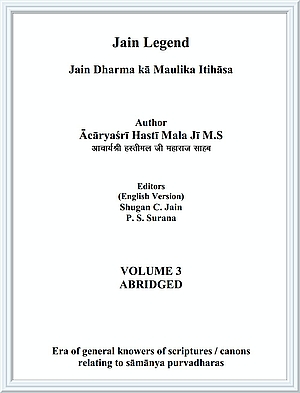After the death of Devardhigaṇi Kṣamāśramaṇa, the material based religious traditions in Jainism had almost totally replaced its true and original spirituality based tradition. Jain followers started believing these new material based traditions as original.
The serious practitioner monks of true Jain doctrine started getting worried with new prosperity and influence of laxity in the conduct of monks and associated material based worships and religious rituals.
Many serious practitioner monks and ācāryas of true Jain doctrine made many efforts to establish the influence of the original spirituality based Jain tradition but their attempts did not produce satisfactory results. Still, these ācāryas did not lose heart and kept on trying. Their efforts did produce partial success also. Here it will not be out of place to say that even the partial successes of these reformist ācāryas could not replace their failures. The main cause for their failure was the use of material based and attractive religious rituals by other materials based Jain congregations which have made deep impressions in the minds of Jain followers and rulers alike as true religion and became followers of these material based Jain traditions. Thus all the innovations in religious rituals introduced by these materials based traditions made deep impressions in the minds of all as true religious traditions. Alongwith another reason for the failure of the reformist ācāryas was the attractive material incentives offered by the rulers and their advisers (who were followers of these materials based traditions) to common people. Under the influence of these incentives, it became impossible for the reformist ācāryas to succeed.
These reformist ācāryas, who were true followers of the original doctrine and Śramaņa conduct were extremely worried about the pervert changes made by the material based traditions in the conduct of monks and householders alike. The growing influence of these pervert changes were causing them pain like a thorn in their heart.
A detailed review of Mahā Niśītha indicated that introduction of these changes in the code of conduct by different material based traditions if not introduced with some restrictions at different places in Mahā Niśītha may produce disastrous results in future. With these concerns uppermost in their minds, these reformist ācāryas of the psychic traditions of Jain congregation tried to reconcile with all other material based traditions of various congregations, gacchas and gaṇas who had earlier drifted away from them. From the existence of many writings in Maha Niśītha in its present version, one can easily conclude that Ācārya Hari Bhadra in Vikram 757-827, had introduced many improvisations and rewrote many parts of MahāNiśītha.
The only manuscript of Mahā Niśītha available at that time as original now had many parts of it being destroyed by termites. There were many lines / many words and at times many pages (as much as 3) were destroyed. The main objective in rewriting and improvising this termite infested manuscript of Mahā Niśītha, of Hari Bhadra and eight other friends of different congregations, was to eliminate the growing differences and rivalries prevailing amongst different Jain congregations, as well as to bring reconciliation amongst many congregations, gacchas, gaṇas and other formations in Jain congregation. Therefore Hari Bhadra and eight other ācāryas of different congregations improvised Mahā Niśītha by introducing many pages having interlinked changes in Mahā Niśītha. Hari Bhadra and other Ācāryas also introduced such daily religious rituals for Jain followers which were hitherto totally prohibited in original scriptures. Such acts of these reformist ācāryas lead us to infer that these ācāryas accepted the changes in conduct that has been made so far by the materials based traditions or that has been deeply ingrained in the minds of the followers as religiously correct or those traditions which were difficult to be eliminated, acceptable as an integral part of the original code of conduct and doctrine.
To reconcile the irreconcilable problem / conflict among the materials based and psychic based traditions, Hari Bhadra and eight other ācāryas unanimously accepted the changes made by material based traditions so far. Perhaps the second reconciliation accepted unanimously by these ācāryas was of changes introduced by temple dwellers tradition early during their formative period and deeply ingrained in the minds of the follower of Jainism. Alongwith idol worship, even the use of mantras and attainment of various extra ordinary powers were also included in the religious duties of the followers.
Thus with the noble objective of bringing about reconciliation amongst various sects, gaṇas and traditions prevailing in Jain congregation at that time and to unify them as one; Hari Bhadra and other reformist ācāryas of that time, and in the spirit of reconciliation using the path of improvising Niśītha included all the prevailing rituals of idol worship, use of mantras, attaining extraordinary powers etc which were introduced by various materials based Jain traditions, as a part of daily religious rituals of the followers of Jainism.
This was a unique and historical step to bring all Jain congregations with different traditions into the fold of one unified Jain congregation. However these efforts not only failed but even resulted in long term ill effects as well.
Those ācāryas, who were believers and followers of the original doctrine and code of conduct depicted by Omniscient Lord Mahāvīra, did not accept at all in any manner these changes practiced by the ācāryas of that time and incorporated by Hari Bhadra in Niśītha in spirit of reconciliation.
Another long term ill effect of the reconciliatory approach adopted by Hari Bhadra was that the changes incorporated in Maha Niśītha of the rituals prevailing at that time as religious activities were accepted by the Suvihita tradition but the temple dwellers and other traditions did not accept them in Toto.
 Acharya Hasti Mala
Acharya Hasti Mala
